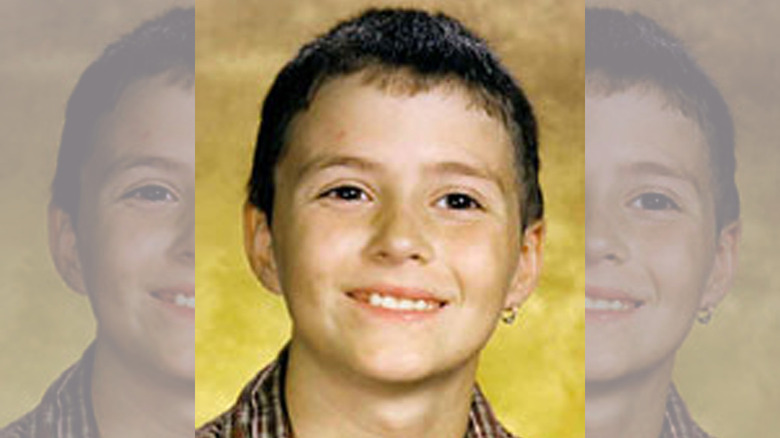The Worst Cases Of Stockholm Syndrome
Being held against your will is undoubtedly a traumatic experience. So it's not surprising that there is a psychological cost to that experience. The idea that you'll suffer some post-traumatic stress seems pretty reasonable, but there's a different psychological reaction that's more difficult to comprehend: so-called Stockholm syndrome, when captives come to identify with and have a strong positive bond with their captors.
Psychologists speculate that the root cause of this bizarre reaction stems from the threat to the captive's life: When the kidnapper or hostage-taker chooses not to kill or harm their captive, the sense of relief mutates into a feeling of affection and gratitude driven by the survival instinct. While there are many instances throughout history of prisoners developing friendships or other strong bonds with their captors, the concept of Stockholm syndrome as a definable psychological mechanism is a relatively recent development that dates back only to the 1970s. In fact, there remains considerable disagreement surrounding the idea: It isn't an officially recognized psychological disorder, and many argue it's a misogynistic and distorted view of people's reactions to the trauma of captivity.
That being said, there have been many modern examples of captives cooperating with their captors, or emerging from their ordeal with a surprisingly positive opinion of them. Here are some of the worst cases of Stockholm syndrome ever recorded.
Mary McElroy: An early case
An early recorded case of what might have been Stockholm syndrome involved 25-year-old Mary McElroy, the daughter of powerful Kansas City politician Henry F. McElroy. As noted by the New York Daily News, McElroy was taking a bath on a Saturday morning in May of 1933 when two masked men entered the house with a shotgun and kidnapped her — after giving her time to dry off and get dressed.
According to author Michael Newton in his book "The Encyclopedia of Kidnappings," the four men involved with the kidnapping plot were led by Walter McGee. (Time notes that his brother, George, and a man named Clarence Glick were also involved.) Mary was chained to a cellar wall. The gang demanded $60,000 ransom from Mary's father, but he only paid $30,000. Just 29 hours after being abducted, Mary was released, holding roses given to her by her captors.
All four men were arrested. Mary advocated for them, testifying on their behalf and pleading with the authorities when Walter McGee was given the death penalty. She visited her captors in jail and maintained her friendship with them until the end of her life — when she died by suicide in 1940, she wrote in her suicide note that "My four kidnappers are probably the four people on earth who don't consider me an utter fool."
If you or anyone you know is having suicidal thoughts, please call the National Suicide Prevention Lifeline at 1-800-273-TALK (8255).
The Norrmalmstorg Robbery: The trope namer
As noted by the encyclopedia Britannica, the term "Stockholm syndrome" dates to 1973, inspired by the botched robbery of the Sveriges Kreditbanken in Stockholm's Norrmalmstorg town square. As reported by History, safe-cracker Jan-Erik Olsson entered the bank with a submachine gun and took four employees hostage: Birgitta Lundblad, Elisabeth Oldgren, Kristin Ehnmark, and Sven Safstrom. He demanded that his friend and criminal partner Clark Olofsson be released from prison and delivered to the bank, and Swedish police complied. The hostages were held for more than five days before the police used tear gas to rush into the bank and arrest Olofsson and Olsson.
None of the captives were harmed, but they exhibited unexpected sympathy for their captors. By the second day of the ordeal, the hostages were calling the kidnappers by their first names, and began to regard the police as the real danger. As noted by Esquire, on the fourth day, Ehnmark actually phoned the prime minister and asked to be allowed to accompany the kidnappers as they left the bank to ensure they were not harmed.
According to BBC News, psychologists worked to explain the attitude of the hostages — they had described their captors as "very kind," and Safstrom had even considered going along with the kidnappers' plan to shoot him in the leg in order to convince police to acquiesce to their demands. Psychiatrist Nils Bejerot first used the phrase "Stockholm syndrome," but psychiatrist Frank Ochberg codified it for law enforcement in the ensuing years.
Patty Hearst: Heiress to revolutionary
For most people, the phrase "Stockholm syndrome" immediately brings to mind one of the most famous kidnappings in modern history: Patty Hearst. According to the encyclopedia Britannica, Hearst was born into the uber-wealthy empire founded by William Randolph Hearst, and lived a relatively normal life. In 1974 she was attending classes at the University of California in Berkeley when she was abducted from her apartment.
NPR explains that her kidnappers were members of the Symbionese Liberation Army, a rag-tag group of radicals who lacked any kind of coherent ideology. (They never had more than 12 members, and their name was meaningless.) Two months later, Hearst shocked the world by announcing her allegiance to the group and publicly participating in a bank robbery with them — carrying an automatic rifle. Time notes that there was speculation that Hearst had participated involuntarily, but when the FBI tracked her down 19 months after her abduction, they charged her as a criminal.
Her defense team argued that she'd been brainwashed — a victim of severe Stockholm syndrome. In fact, she had once been left alone in a van with the keys in the ignition, but made no attempt to escape. The jury convicted her. Hearst became the public face of the concept anyway, and to this day no one is certain whether she suffered a psychological break, cooperated to ensure her safety, or truly joined forces with her inept captors.
Jaycee Lee Dugard: A horrific coping mechanism
The facts are grim and almost unbelievable. As reported by KXTV, on June 10, 1991, an 11-year-old girl named Jaycee Lee Dugard was abducted off the street as she walked to the bus stop. Phillip Garrido and his wife Nancy held Jaycee captive for the next 18 years in their backyard. Phillip repeatedly sexually assaulted Dugard, fathering two children with her.
As CBS News reports, the horrific crime was only revealed when Jaycee and her children accompanied Phillip Garrido to a meeting with his parole officer. When officers became suspicious, Garrido confessed and Jaycee was finally free. But this led to the question of why Jaycee had never made any attempt to escape — as noted by The Guardian, the Garridos regularly took Dugard out in public. It's easy to see Dugard as a victim of Stockholm syndrome: According to forensic psychiatrist Dr. Keith Ablow in John Glatt's book "Lost and Found," children have fewer coping mechanisms than adults, and Dugard may have had "little alternative but to bond with her captors" in order to survive.
When Dugard was reunited with her mother after nearly two decades in captivity, she said that she felt guilty for not having escaped — and for having bonded with Garrido.
If you or anyone you know has been a victim of sexual assault, help is available. Visit the Rape, Abuse & Incest National Network website or contact RAINN's National Helpline at 1-800-656-HOPE (4673).
Colleen Stan: The girl in the box
In 1977, 20-year-old Colleen Stan decided to hitchhike to a friend's house as a birthday surprise. According to the New York Daily News, Stan had done a lot of hitchhiking and was smart enough to know how dangerous it could be. When Cameron Hooker pulled over to offer her a ride, she accepted because his wife, Janice, and their baby were with him.
Then Hooker pulled a knife, abducted her, placed a wooden box over her head, and imprisoned her for the next seven years. According to CBS News, the Hookers kept Stan as a slave, and forced her to spend much of her time in a coffin-like box he kept under his bed. Stan was repeatedly assaulted and forced to sign a contract agreeing to be a slave.
And yet, as time went on, Stan had many opportunities to escape. Hooker even took Stan home to visit her family — and left her there overnight. Stan said nothing, and returned to the Hookers' home and the box under the bed. And when Janice Hooker began to feel remorse and helped Stan escape, she asked Colleen not to turn in Cameron — and Stan agreed. It wasn't until Janice turned Cameron in that the full story was finally revealed.
If you or anyone you know has been a victim of sexual assault, help is available. Visit the Rape, Abuse & Incest National Network website or contact RAINN's National Helpline at 1-800-656-HOPE (4673).
Natascha Kampusch: Mourning her captor
According to The Guardian, when Natascha Kampusch was 10 years old, she daydreamed about suicide. Her home life was unhappy, and she imagined the remorse her mother would feel if she were to jump in front of a car. Then a man named Wolfgang Priklopil grabbed her off the street and pulled her into his van. He drove to his home and forced her into an elaborate prison cell, where he kept her for more than eight years. After a few years of treating her relatively gently, Priklopil reacted to her increasing rebellion with violence — beatings, psychological torture, and forced labor. At the same time, he took her out frequently — and once even took her on a skiing holiday.
She made no attempt to escape until she was 18. One day, when he was distracted by a phone call, she simply walked out of the garden and ran. Priklopil killed himself, and initially Kampusch was greeted with sympathy. But as ABC News reports, when asked about her tormentor, her initial response was, "I mourn for him in a certain way." Combined with her inability to escape when given the opportunity, it seemed likely that Kampusch suffered from a classic case of Stockholm syndrome and had bonded with Priklopil in a desperate, subconscious attempt at survival.
If you or anyone you know is having suicidal thoughts, please call the National Suicide Prevention Lifeline at 1-800-273-TALK (8255).
Shawn Hornbeck: Could have escaped
As reported by Newsweek, when Shawn Hornbeck was 11 years old, he was kidnapped by a man named Michael Devlin. Fox2Now reports that Hornbeck took his bike out for a ride, and Devlin hit him with his pickup truck, knocking him off the bike. Devlin transported Hornbeck to his home 60 miles away. For the next four years, Hornbeck apparently lived a relatively free existence — although there were reports of "whimpering" and "screaming" coming from Devlin's apartment, neighbors also reported seeing Hornbeck walking around freely without Devlin. And yet the boy never made any attempt to escape. As noted by ABC News, this behavior could be explained by Stockholm syndrome.
Hornbeck might have remained Devlin's prisoner forever if the kidnapper hadn't gotten the urge again. Four years later, Devlin abducted a second boy named Ben Ownby — but this time someone got a good look at his truck. When the FBI caught up with him, they found both boys alive and well and playing video games in the living room. Devlin admitted he'd taken Ownby because Hornbeck was getting too old. Once rescued, Hornbeck described being restrained by Devlin and nearly strangled to death. Devlin was convicted on all charges brought against him; Fox2Now reports he was sentenced to 74 life terms and an additional 2,020 years in prison.
Steven Stayner: Layers of tragedy
In 1972, 7-year-old Steven Stayner was walking home from school. SFGATE reports that Kenneth Parnell approached the boy and told him his mother had asked Parnell to pick him up. Steven willingly got into Parnell's car and was lost for seven years. Parnell told Steven that his parents no longer wanted him, and renamed him Dennis.
According to ABC News, Parnell moved around with Steven frequently, never staying anywhere for very long. Steven lived a superficially normal life, attending school intermittently, but at night Parnell would assault him and remind him that his parents had given him away. The New York Post reports that this "brainwashing" worked, and Steven admits that "after a while, I was happy." Steven was terrified of Parnell, but also resigned to his new reality.
When Parnell kidnapped 5-year-old Timothy White and began abusing him as well, however, Steven was jolted out of this warped alternate universe. One night after Parnell went to work, Steven took Timmy and ran. They caught a ride to Timmy's hometown, and Steven finally went to the police. Steven had been "Dennis" for so long, he had trouble remembering his real name. Tragically, a decade later Steven was hit by a car while riding his motorcycle and died, aged just 24. His brother, Cary, later assaulted and killed four women near Yosemite National Park, and is currently serving a life sentence.
Elizabeth Smart: Determined to survive
According to History, 14-year-old Elizabeth Smart was kidnapped from her bedroom in Salt Lake City by Brian David Mitchell, who had once worked for Smart's family. Mitchell took Smart to a campsite a few miles away and sexually assaulted her. For months, Smart was held captive by Mitchell and his wife, Wanda Barzee. She was abused and forced to wear a wig and veil. As noted by Mother Jones, Smart was often out in public during this time and likely had opportunities to escape, but did not.
When Mitchell and Barzee returned to Salt Lake City after spending the winter in San Diego, Smart was recognized, and the couple was arrested. Strangely, Smart initially refused to identify herself — The Cape Cod Times reports that her first words to police were, "I know who you think I am. You guys think I'm that Elizabeth Smart girl who ran away." According to police, she initially expressed concern for Mitchell and Barzee, worrying over their welfare.
The New Yorker reports that Smart resents the theory that she experienced Stockholm syndrome, insisting that she did what she had to in order to survive. As noted on Today, she says she "despised" Mitchell and Barzee, and explicitly rejects the categorization of Stockholm syndrome.
If you or anyone you know has been a victim of sexual assault, help is available. Visit the Rape, Abuse & Incest National Network website or contact RAINN's National Helpline at 1-800-656-HOPE (4673).
Mackenzie Phillips: Her own father
Typically, when we think of Stockholm syndrome we think of hostages and kidnap victims, people forcibly taken from their familiar lives. But in the case of actress Mackenzie Phillips, she experienced the phenomenon with someone who should have been her safe harbor: her own father.
As reported by ABC News, Phillips recounted in her autobiography that she passed out after a drug binge at the age of 18 and woke up to find her father sexually assaulting her. She proceeded to have a consensual, drug-fueled relationship with him for the next decade. According to CNN, Phillips herself has used the term "Stockholm syndrome" to describe her psychological reaction to this abuse. Her acceptance of the relationship ended when John Phillips, a musician and part of the famous rock group the Mamas and the Papas, began talking about moving to Fiji with his other children and living with Mackenzie as his wife. "The moment he tried to make it romantic," she said, "I thought, we're going to hell for this."
The relationship continued, however, until Phillips became pregnant. Today notes that her father arranged to have the pregnancy terminated, and Phillips ended the relationship for good.
If you or anyone you know has been a victim of sexual assault, help is available. Visit the Rape, Abuse & Incest National Network website or contact RAINN's National Helpline at 1-800-656-HOPE (4673).
The hijacking of TWA flight 847: Sympathy for the Devil
According to History, in June of 1985 TWA Flight 847 was hijacked by Shiite Hezbollah terrorists, who initially demanded the identities of passengers who might be Jewish. The hijackers then forced the plane to land in Beirut, where they soon murdered one of the hostages, an American U.S. Navy construction diver named Robert Stethem. While most of the passengers were released quickly, five men were held for the next 17 days before being released unharmed.
As noted by The Washington Post, many outside observers were puzzled at the sympathetic attitude of the hostages. Many expressed sympathy for the hijackers and echoed their demands. In a clear case of Stockholm syndrome, it seems likely that many of the captives transferred their anger to the authorities who refused to comply with the demands of the hijackers. From their perspective, compliance would have ended the ordeal immediately. Instead, the United States and Israel refused, extending the hostages' terrifying ordeal.
Although the hostages were held in dirty, roach-infested cells, they were treated fairly well, all things considered. They were not beaten, and they were fed regularly. The Chicago Tribune reports that most of the hostages reject the characterization of Stockholm syndrome. But they admit that the relatively good treatment they received did make them see their captors in a better light — which is often a classic symptom of the syndrome.
Terry Anderson, Terry Waite, Thomas Sutherland: Four years as hostages
During what History describes as "the Lebanon hostage crisis" in the 1980s, nearly a hundred foreigners were abducted and held in Beirut as terrorists, among them Thomas Sutherland, Terry Anderson, and Terry Waite. The three men would be held for incredibly long periods of time — Sutherland for 2,353 days, Anderson for 2,455 days, and Waite for 1,763 days. As captives, the men were often blindfolded and beaten, and were even made to believe they were about to be executed on several occasions. According to CNN, Sutherland was once beaten with a rubber truncheon that left black and blue bruises all over his body. Perhaps worst of all, their captors often teased the men that they were about to be released solely to inflict psychological pain on them.
And yet the encyclopedia Britannica notes that all three men claimed to have been treated "well" by their captors, and in the SAGE Encyclopedia of Terrorism, the three men are described as having suffered from Stockholm syndrome. In fact, The Coloradoan reports that Sutherland explicitly believes that Stockholm syndrome was "exactly" what he experienced, describing it as identifying with his captors and believing they're "doing the right thing."












